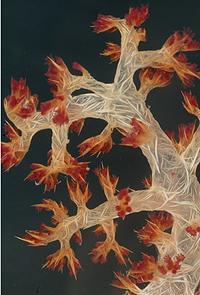 探索著久為潛水員所熟悉的澳洲珊瑚礁群,海洋研究團隊驚喜地發現上百個新品種軟珊瑚和其他種類的動物,而且,這些物種過去未曾被科學家所提及。研究人員也指出,各種對珊瑚礁群生物多樣性的威脅,使得澳洲珊瑚礁群的生物清查顯得更為急迫且優先。
探索著久為潛水員所熟悉的澳洲珊瑚礁群,海洋研究團隊驚喜地發現上百個新品種軟珊瑚和其他種類的動物,而且,這些物種過去未曾被科學家所提及。研究人員也指出,各種對珊瑚礁群生物多樣性的威脅,使得澳洲珊瑚礁群的生物清查顯得更為急迫且優先。
「珊瑚正面臨各種威脅,不論是從海洋酸化、污染、暖化,或是過分捕撈和海星大量繁殖。唯有設立生物多樣性的底線並追蹤新近的普查資料,人們才能瞭解那些威脅所帶來的影響並找出能夠減輕衝擊的線索。」澳洲海洋科學研究所首席執行官Ian Poiner博士說,該研究機構領導此項研究計畫。
在大堡礁,世界的最長的珊瑚礁群,這些科學家於4月2日到22日間考察蜥蜴島,並從8月25日到9月14日這段期間更進一步探索更南方的蒼鷺島。還有一次是自6月5日到25日探訪西北澳離岸的Ningaloo珊瑚礁。這3 次探險各自花費3周,出動了約25名成員。
在今後3年內,研究團隊每年將對這3個地點進行重複考察,以繼續更新盤點清單,並且偵測氣候變化所帶來的影響和其他程序。
 澳洲考察是一項前所未有的全球珊瑚礁普查計畫(CReefs)的一部份。該計畫是17項海洋生物普查之一。 「在珊瑚礁群上極其豐富的珊瑚和魚類,長期以來吸引著潛水員,但是我們對這些棲息地中其他物種多樣化感到驚訝。成千上萬個生命形式正等著被發現。關於海洋生物多樣性的知識影響著很多層面,其中或許還包括人類的健康 - 這些動物之一可能對人類有巨大的價值。」 海洋生物普查的首席科學家Ron O'Dor說。
澳洲考察是一項前所未有的全球珊瑚礁普查計畫(CReefs)的一部份。該計畫是17項海洋生物普查之一。 「在珊瑚礁群上極其豐富的珊瑚和魚類,長期以來吸引著潛水員,但是我們對這些棲息地中其他物種多樣化感到驚訝。成千上萬個生命形式正等著被發現。關於海洋生物多樣性的知識影響著很多層面,其中或許還包括人類的健康 - 這些動物之一可能對人類有巨大的價值。」 海洋生物普查的首席科學家Ron O'Dor說。
參與CReefs的科學家想多瞭解究竟有多少種生物在珊瑚礁群中生活,有那些是屬於珊瑚礁群的特有種,而他們如何對人類騷擾出回應。
朱利安‧卡利博士,這位在CReefs 工程的目的和共同領導人的主要研究科學家說,這3個已探查的珊瑚礁群座落在擁有不同生物多樣性的兩個海洋盆地中。 「相較於我們所未知的,我們的海洋生物知識如同海洋中的一滴水。替所有海域的多樣物種和豐富的生命型態進行盤點,正挑戰著科學和人們的想像。」卡利博士說道。
在3次考察中,科學家發現︰
- 大約300種軟珊瑚中,多達一半以上屬於科學上的新發現。
- 許多小型甲殼物種 – 其中有一個以上的科是目前科學所未知的。
- 顯少被取樣的Maxillipiidae科的片腳類物種。擁有約其身體3倍大小,古怪的鞭狀後腿為其特色。只有一些種類在全世界有過記錄 。
- 新種的異足虫甲殼動物,是一種像蝦一樣的動物,有些擁有比他們的身體還長的螯。
- 美麗,稀有的仙后座水母,在海底頭下腳下的被拍到,觸角在水柱中揮動 – 該姿勢使共生的海藻生活在其觸角中以捕捉陽光進行光合作用。
- 許多極小的片腳類甲殼動物──海洋世界的昆蟲,估計其中的40%到60%第一次被正式紀錄。
雖然這些豐富的物種並不構成珊瑚礁群,但他們統治著我們研究過的一些地區,並遍布約海底25%的區域。
 「這次新的澳洲考察顯示了我們對於有多少種物種生存在全球各珊瑚礁群所知甚微。」 隸屬位於華盛頓的斯密森學會,也是CReefs另一首席調查員南茜‧諾爾頓博士說。
「這次新的澳洲考察顯示了我們對於有多少種物種生存在全球各珊瑚礁群所知甚微。」 隸屬位於華盛頓的斯密森學會,也是CReefs另一首席調查員南茜‧諾爾頓博士說。
O'Dor博士對珊瑚礁種類的演化很感興趣。「即使在這低等的範圍,我們必定想瞭解大自然為何在珊瑚礁群中演化出如此多樣的物種。他們代表著生物多樣性,但造成並維持珊瑚礁群生物多樣性的過程仍是個未知的領域。」 「海洋生物的普查」是一個由80餘國研究員所組成的國際網絡,進行一項10 年行動,評估並解釋海洋生物的差異、分布,以及多樣性,並橫跨過去、現在,和未來。
Teams of marine researchers exploring Australian reefs long known to divers have been surprised and delighted to find hundreds of new kinds of soft corals and other animal species never before described by scientists. The researchers say multiple threats to coral biodiversity make the scientific inventory of life on Australia's reefs an urgent priority.
"Corals face threats ranging from ocean acidification, pollution, and warming to overfishing and starfish outbreaks," says Dr. Ian Poiner, chief executive of the Australian Institute of Marine Science, which led the research. "Only by establishing a baseline of biodiversity and following through with later censuses can people know the impact of those threats and find clues to mitigate them."
On the Great Barrier Reef, the world's longest coral reef, the scientists explored Lizard Island from April 2 to 22 and, further south, Heron Island from August 25 to September 14.
An expedition visited Ningaloo reef off northwestern Australia from June 5 to 25. Each of the three expeditions took three weeks and included about 25 members.
Expeditions to the same three sites will be repeated annually over the next three years to continue their inventory and measure impacts of climate change and other processes over time.
The Australian expeditions are part of an unprecedented global census of coral reefs, CReefs, one of 17 Census of Marine Life projects.
"Amazingly colorful corals and fishes on reefs have long dazzled divers, but our eyes are just opening to the astonishing richness of other life forms in these habitats," says Census of Marine Life Chief Scientist Ron O'Dor.
"Hundreds of thousands of forms of life remain to be discovered. Knowledge of this ocean diversity matters on many levels, including possibly human health - one of these creatures may have properties of enormous value to humanity," said Dr. O'Dor.
Scientists with CReefs Australia want to learn how many species live on coral reefs, how many of these are unique to coral reefs and how do they respond to human disturbance.
Dr. Julian Caley, principal research scientist at AIMS and co-leader of the CReefs project, says the three explored coral reef sites are located in two ocean basins with different levels of biodiversity.
"Compared to what we don't know, our knowledge of marine life is a proverbial drop in the ocean," Caley said. "Inventorying the vast diversity and abundance of life across all ocean realms challenges both science and the imagination."
- On the three expeditions, scientists discovered:
- About 300 soft coral species, up to half of them thought to be new to science
- Dozens of small crustacean species - and potentially one or more families of species also thought unknown to science
- A rarely sampled amphipod of the family Maxillipiidae, featuring a bizarre whip-like back leg about three times the size of its body. Only a few species are recorded worldwide
- New species of tanaid crustaceans, shrimp-like animals, some with claws longer than their bodies
- The beautiful, rare Cassiopeia jellyfish, photographed upside down on the ocean floor, tentacles waving in the water column - a posture that enables symbiotic algae living in its tentacles to capture sunlight for photosynthesis
- Scores of tiny amphipod crustaceans - insects of the marine world - of which an estimated 40 to 60 percent will be formally described for the first time
- While the colorful animals are not reef builders, they dominate some of the areas studied, covering up to 25 percent of the ocean floor.
"The new Australian expeditions reveal how far we are from knowing how many species live in coral reefs around the globe. Estimates span the huge range from one to nine million, says Dr. Nancy Knowlton of the Smithsonian Institution in Washington, another principal investigator with CReefs.
Dr. O'Dor is curious about the evolution of coral reef species. "Even at the low end of this range, we must wonder why nature has evolved such prolific diversity on coral reefs," he said. "While they are icons of diversity, the processes that have generated and maintained coral reef biodiversity are still unknown."
The Census of Marine Life, online at http://www.coml.org, is a global network of researchers in more than 80 nations engaged in a 10 year initiative to assess and explain the diversity, distribution, and abundance of marine life in the oceans - past, present, and future.




